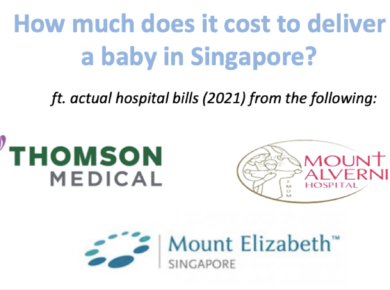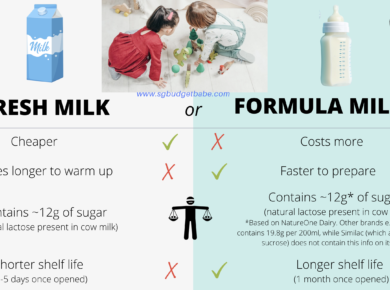Hello! This is a much requested post from many of you, who contacted me in private requesting for my comparison table, so I’ve decided to share my findings publicly here. All data are consolidated from my individual meetings with the sales representatives across all three companies (so if there’s any data that is wrong / outdated, please let me know so I can change it, but I will not be held liable for any misinformation in this table as I’m merely replicating what their sales reps told me!).
I’ve also previously written on whether I feel cord blood banking is necessary, and why I’m not entirely for the idea of donating it to the Singapore Cord Blood Bank (SCBB) vs. storing it privately here. I’ve also reviewed about how SCBB’s Family Banking Initiative costs stack up against the private banks – essentially it works out to be almost pretty much the same, except that you don’t get any freebies (such as $300+ UV sterilizers for baby bottles and hygiene and/or insurance, so it actually pales in comparison from a value perspective).
This table has been updated as of 2020 to reflect changes.
|
Cordlife
|
Stemcord
|
Cryoviva
|
|
|
Accredited by MOH, AABB and FACT
Note: All cord blood banks operating in Singapore are required to have MOH license. AABB = Accredited Cord Blood (CB) FacilitiesFACT = Foundation for the Accreditation of Cellular Therapy |
✔
Certified by MOH Accredited by AABB (8 times) and FACT (2 times) |
✗
MOH & FACT (3 times)
|
✗
MOH & AABB
*Has ISO9001 certification, but not FACT (which is specific to the cord blood banking industry) 2020 update: Cryoviva has now obtained AABB accreditation, which it did not have in 2018 when I needed to bank for my first child
|
|
Owns their own storage facility
|
A’Posh Bizhub at Yishun
|
100 Pasir Panjang and Tradehub 21
|
Jalan Pemimpin (Bishan), Mapex Building
|
|
Units stored so far
|
400,000
|
41,000
|
120,000 in Singapore, Thailand and India
2020 update: 160,000
|
|
Stores in 2 separate bags
|
✗
|
✔
|
✗
|
|
Quality of processing
|
SEPAX 2 and Smart-Max
(since 2008)
|
SEPAX 2
(since 2012) |
SEPAX 2
(since 2014) |
|
Years of history
|
19 years
(since 2001) |
18 years
(since 2002) |
6
(since 2014. Outside of Singapore, their history is 14 years)
|
|
Successful transplants with its stored samples
|
16 cases
|
Pending Cryoviva’s confirmation
|
|
|
Public company with transparent financial records for public access
|
✔
|
✗
|
✗
|
|
Can store cord blood, cord tissue (i.e. Wharton’s jelly) and cord lining
|
✔
$6,400 for cord blood + tissue (HSC and MSC cells)
$9,998 for cord blood + cord lining (HSC, MSC and EpSC cells) |
✗
$8,800 for cord blood + tissue (HSC and MSC cells)
Not able to store cord lining. |
✗
$6,850 for cord blood + tissue (HSC and MSC cells) Not able to store cord lining. |
|
Price (cord blood storage)
*2018 quotes that we received
|
$5,200
|
$5,500
|
$4,950
|
Our decision then essentially came down to choosing between:
- Want the cheapest? Cryoviva.
- Want the most flexible pricing plans with low commitment? Stemcord.
- Want the one with the best track record / technology / reviews / want to store all 3 types of stem cells? Cordlife.
- A trustworthy blood bank where there’s no risk of contamination or losing of our samples
- One with very low risk of liquidation (we don’t want to have paid for 21 years of storage for nothing!)
- One with the most advanced technology for processing and storing the cord components
We were then left with Cordlife, and the Facebook reviews seemed promising:
The processing
In terms of processing quality, Cordlife is also the first private cord blood bank in Singapore to offer the Sepax®2 automated processing technology, which can recover as high as 99.88%1 of total nucleated cells from cord blood. It is also a functionally closed processing system which ensures the sterility of the cord blood by eliminating exposure to air contaminants. Stemcord, on the other hand, was previously using a manual closed system (triple bag) which has only 82% recovery, but I was heartened to find out from their sales rep that they’ve since switched over to Sepax-2 since 2012.
The preservation
After maximising the recovery of total nucleated cells from cord blood, the next important step is to carefully prepare the stem cells for cyropreservation, so that the cells can be stored indefinitely while retaining its viability for use in treatments. This is crucial, because you don’t know how many years later you might be needing it, so long-term viability and storage is extremely important. Cordlife is also the first and only family cord blood bank in Singapore to adopt this fully automated cyroprotectant infuser, mixer and cooling device, Smart-Max, which mixes the cyroprotectant with the stem cells in a uniform manner, thus eliminating the need for human intervention (and thus any chances of human error).
The yield of stem cells from the Wharton Jelly is also much lower at 54,000 cells vs. 20 million cells from the cord lining. Cordlife is the only authorised company in Singapore with CellOptima, which is a patented technology to harvest and multiply stem cells from the cord lining.

In other words, if you wish to also store CLEpSC stem cells, Cordlife is the only company in Singapore who can do it for you via CellOptima technology.
This gives me the belief that Cordlife will continue investing in newest and latest technologies to ensure the viability of their processing and stored samples.

Cordlife also stores the cord blood units in a 20-80 bag, so if we reallllllly wanted to just use a little bit and conserve the rest for future treatments, they technically can do that for us as well. This was a concern I raised initially as I read from online reviews that some parents who chose to go with Stemcord decided based on the fact that they don’t have to use up all the cord blood in one sitting. However, all of this ultimately rests on the decision of the medical doctor overseeing the case and depending on the case severity as well anyway, but it is good to know that we also have this option.
This then made me wonder if their service for existing members who are already storing with them are as prompt, or as slow. Although it might be two different teams handling sales and processing, nonetheless, it made me think twice about banking with Stemcord, and so I narrowed my choices down to Cordlife and Cryoviva.
As such, after weeks of arduous research and speaking with a sales representative from each of the companies (including calling SCBB, to understand about donating vs. private banking), my husband and I have decided to go with Cordlife for storing of our baby’s cord blood, tissue and lining. Call us kiasu, but we’ll rather be safe than sorry.
I was initially only for the idea of storing the cord blood because of the cost, but as my husband says, “We only have to give up on one Europe family vacation just to afford it. This is worth it, let’s not have any regrets.”
Sounds similar to what another mummy shared online!
Anyway, I hope my homework will bless future parents-to-be and aid you in making your own informed decision as well! While I’ve chosen Cordlife for my own, ultimately please review the pros and cons of each provider and decide for yourself which is the best for you and your baby.
Disclaimer: Information in this post is accurate to the best of my knowledge as of 2018 and was updated on 7 September 2020. I have reached out and personally spoken with each of the companies’ sales representatives in order to consolidate the table of comparisons here to try and ensure I’ve gotten my data right. If any mistakes are spotted, please feel free to reach out to me with the correct data and I’ll recheck to ensure accuracy of information is properly reflected.
With love,
Budget Babe










2 comments
Hi SGBB, out of curiosity, did you decide to store just cord blood, cord blood & tissue, or cord blood & cord lining? Thanks!
We were initially only for storing cord blood due to cost, but my husband decided that it'll be better to store all 3 types of stem cells so that we don't have any "what ifs" in the future (and just forgo one Europe family vacation to fund it for the next 21 years). These 3 types – found in the cord blood + tissue + lining – is only available with Cordlife. Hope that helps! Please do speak with the respective sales reps to understand more (and using my post / comparison table as a gauge) and make your own decision based on your affordability and comfort levels though 🙂
Comments are closed.